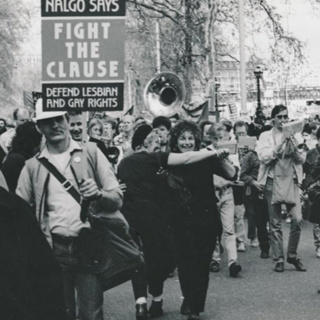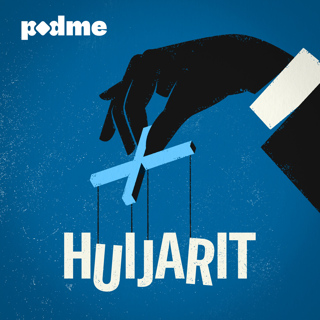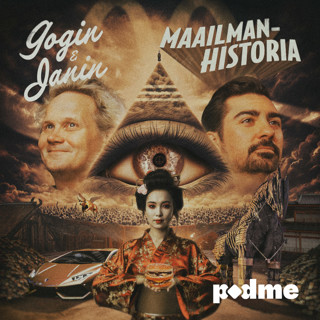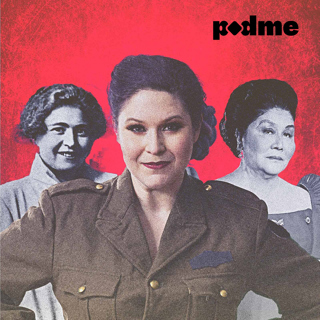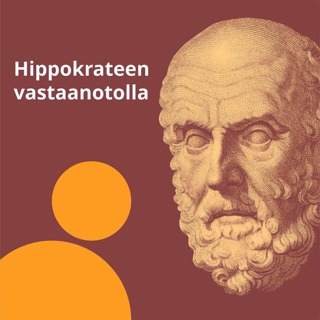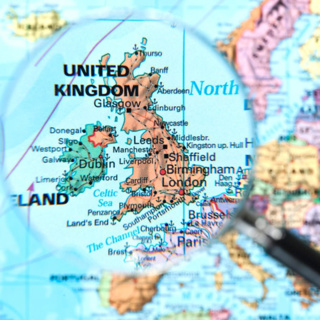
110. The choice: wielding a big stick or speaking softly
As Melbourne left the scene, so men like John Russell could step into his place. Russell had indeed been adding to his reputation as a liberal, just as his Whig Party was increasingly being transformed into the Liberal Party. A fellow liberal, but increasingly a rival, was Lord Palmerston. He was highly critical of his successor as Foreign Secretary, Lord Aberdeen, but the behaviour Palmerston denounced as weak seems more a case of using soft speech, rather than simply wielding a big stick. How he handled tensions with America rather supports that viewpoint. By way of contrast, Aberdeen did sometimes resort to the stick, in particular in two conflicts that Palmerston had got going, in China and in Afghanistan, and in the first it was ugly, while in the second it was disastrous. Illustration: Elizabeth Butler Remnants of an army, showing William Brydon reaching the British fort at Jalalabad, after the retreat from Kabul. Music: Bach Partita #2c by J Bu licensed under an Attribution-NonCommercial-No Derivatives (aka Music Sharing) 3.0 International License
2 Loka 202214min

109. Curious Triangle: Melbourne, Victoria and Peel
The curious relationship continues between Queen Victoria and her first Prime Minister, Viscount Melbourne. It is, however, perhaps less easy than in the past, as the young queen becomes more wilful, more determined on getting her way. One of the things the queen’s particularly determined about is not having that “cold unfeeling disagreeable man” Peel as Prime Minister. However, when Melbourne decides it’s time to resign, the first choice to replace him, the Duke of Wellington, says it has to be Peel. She brings herself to see the man she dislikes so much, and manages, on this occasion, to put him off. So she forces her favourite, Melbourne, ageing and increasingly unwell, back into office. She can’t pull it off a second time, though. On the back of a good election win, Peel finally forms a government with a solid majority behind him. He brings into office many of the old crowd – Aberdeen, Stanley, the dynamic and thrusting Gladstone. But one man he leaves out: the new young MP for Maidstone, Benjamin Disraeli. That may turn out not to have been his wisest decision. Illustration: A dramatic encounter between the Duke of Wellington, dressed in armour bearing a large sword, and Queen Victoria with Lord Melbourne kneeling in supplication and two ladies in waiting. Coloured lithograph by H.B. (John Doyle), 1840. Music: Bach Partita #2c by J Bu licensed under an Attribution-NonCommercial-No Derivatives (aka Music Sharing) 3.0 International License
25 Syys 202214min

108. Palmerston, sometimes a liberal, always an activist
After the last few episodes and their focus on domestic issues, you could be forgiven for thinking that the Grey and Melbourne governments had practically no foreign policy. Nothing could be further from the truth. As a global power with a huge empire, Britain was actively pursuing foreign policy objectives. And in Lord Palmerston, it had a foreign minister far more activist than, Melbourne, to guide it. In some instances that went well. But, as today, Afghanistan would prove a problem. Then when Britain used military force against China to maintain its right to push narcotics into that sad and declining empire, you might even find that it had behaved shamefully. Illustration: Henry John Temple, 3rd Viscount Palmerston in 1844-45, by John Partridge National Portrait Gallery 1025 Music: Bach Partita #2c by J Bu licensed under an Attribution-NonCommercial-No Derivatives (aka Music Sharing) 3.0 International License
18 Syys 202214min

107. The tale of Melbourne's return, and of two remarkable women
After Peel’s 100-day stint in office, Melbourne was back. He took advantage of his return to rid himself of some figures he disliked in his government, though he had to keep Palmerston in place, despite his dislike of all activism. That dislike was based on his pursuit of an easy life, so it’s not surprising that though he had a few achievements, there weren’t many and they weren’t spectacular. Much more important were the women who marked his second administration. The first was Caroline Norton, whose husband sued him for adultery. More important still, was the new young Queen who came to the throne in 1837 when her uncle William IV died. Victoria had arrived. Melbourne would be her mentor. Illustration: Queen Victoria, replica by Sir George Hayter, 1863, based on a work of 1838 National Portrait Gallery 1250 Music: Bach Partita #2c by J Bu licensed under an Attribution-NonCommercial-No Derivatives (aka Music Sharing) 3.0 International License
11 Syys 202214min

106. Melbourne's first go, Peel's hundred days
It was time for Melbourne. But not a long time, as the king decided to try the old royal trick of getting rid of a prime Minister, the last time a monarch attempted that. So, like Napoleon, Peel got a hundred days. What’s more this episode takes a look at the curious private life of Melbourne, using the word 'curious' in a broad sense, extending as far as an Epstein-like appetite. In addition, we’ll talk about the search for Peel in Rome, in an expedition executed expeditiously, not that Peel showed any gratitude for it, though it ended with him back in London as Prime Minister. Illustration: William Lamb, Second Viscount Melbourne, by Sir Edwin Landseer, at the time he was Prime Minister in 1836. National Portrait Gallery 3050. Music: Bach Partita #2c by J Bu licensed under an Attribution-NonCommercial-No Derivatives (aka Music Sharing) 3.0 International License
4 Syys 202214min

105. Grey, the Poor and the Irish
Another significant measure passed by the Grey government was a lot less creditable than the Great Reform Act or Abolition of Slavery. The 1834 Poor Law mandated the construction of workhouses and set out to achieve the aim of making public assistance to the unemployed, sick or old, a lot less pleasant than work – an aim often pursued by politicians today as well and which it achieved. It wasn’t that which brought Grey down, however. It was that constant bugbear of British governments, Ireland. Emancipation hadn’t quietened tempers among the Catholic Irish, it had merely refocused anger on another issue, the requirement on the Irish, the majority Catholic, to pay for the support of the Church of Ireland, the equivalent in the island of the Church of England, which was Protestant and immensely wealthy. The effort to do something about that grievance, however, opened splits in the Cabinet, and the resignation of Ministers. In the end, that culminated in the resignation of the Prime Minister himself. Earl Grey was gone. Illustration: Cartoon of the interior of a Workhouse. Public Domain Music: Bach Partita #2c by J Bu licensed under an Attribution-NonCommercial-No Derivatives (aka Music Sharing) 3.0 International License
28 Elo 202214min

104. Votes to the people. Freedom to the slaves. Up to a point...
Just how great was the Great Reform Act? It was passed in an atmosphere that came close to being revolutionary. That drove the passage of the Act. It didn’t, however, make it a revolutionary Act. On the contrary, its aim was much more to head off revolution. Indeed, its entrenchment of landowning interests in the counties, and its extension of the franchise to the middle class but not to workers, it can be seen as an aristocratic act, with only certain provisions taking Britain in a democratic direction. Its immediate impact, though, was substantial. It forced the parties to work far more closely with voters, laying the foundation of the present party system. In turn, that meant parliamentary candidates had to pledge themselves publicly to specific policies. The abolition of slavery was the major one at the first election after the Act. It was carried, the second great achievement of Grey’s government, though the its handling of compensation, specifically who received it and who didn’t, leaves rather a lot to be desired. Illustration: Slaves cutting sugar cane in Jamais. Public Domain Music: Bach Partita #2c by J Bu licensed under an Attribution-NonCommercial-No Derivatives (aka Music Sharing) 3.0 International License
21 Elo 202214min

103. Great Reform
The shift from Tories to Whigs in government in 1830 was dramatic enough, but nothing like as dramatic as the changes that had taken place in Britain as a nation. Both the impact of the Industrial Revolution, creating large new middle and working classes, and the continued decline in the power of the throne, meant that there was a growing and eventually irresistible demand for new groups of people to have a say in power, and that meant in Parliament. That didn’t, however, make Reform a smooth process. There had to be three attempts to get the Reform Act passed, accompanied by a lot of unrest, as well as another General Election which gave Earl Grey, and the Reform movement he led, a huge majority in the House of Commons. Even so, the King got in the way, and the House of Lords did what it could to block the Act or leave it toothless. But, in a further measure of their own increasing powerlessness, they ultimately couldn’t stop it. Britain at last took its first step in Parliamentary reform when the Great Reform Act was passed in 1832. Illustration: Painting by W J Müller of the burning of the Bishop's Palace in Bristol, October 1831, from https://www.brh.org.uk/site/articles/bristol-1831-the-queens-square-uprising/ Music: Bach Partita #2c by J Bu licensed under an Attribution-NonCommercial-No Derivatives (aka Music Sharing) 3.0 International License
14 Elo 202214min
